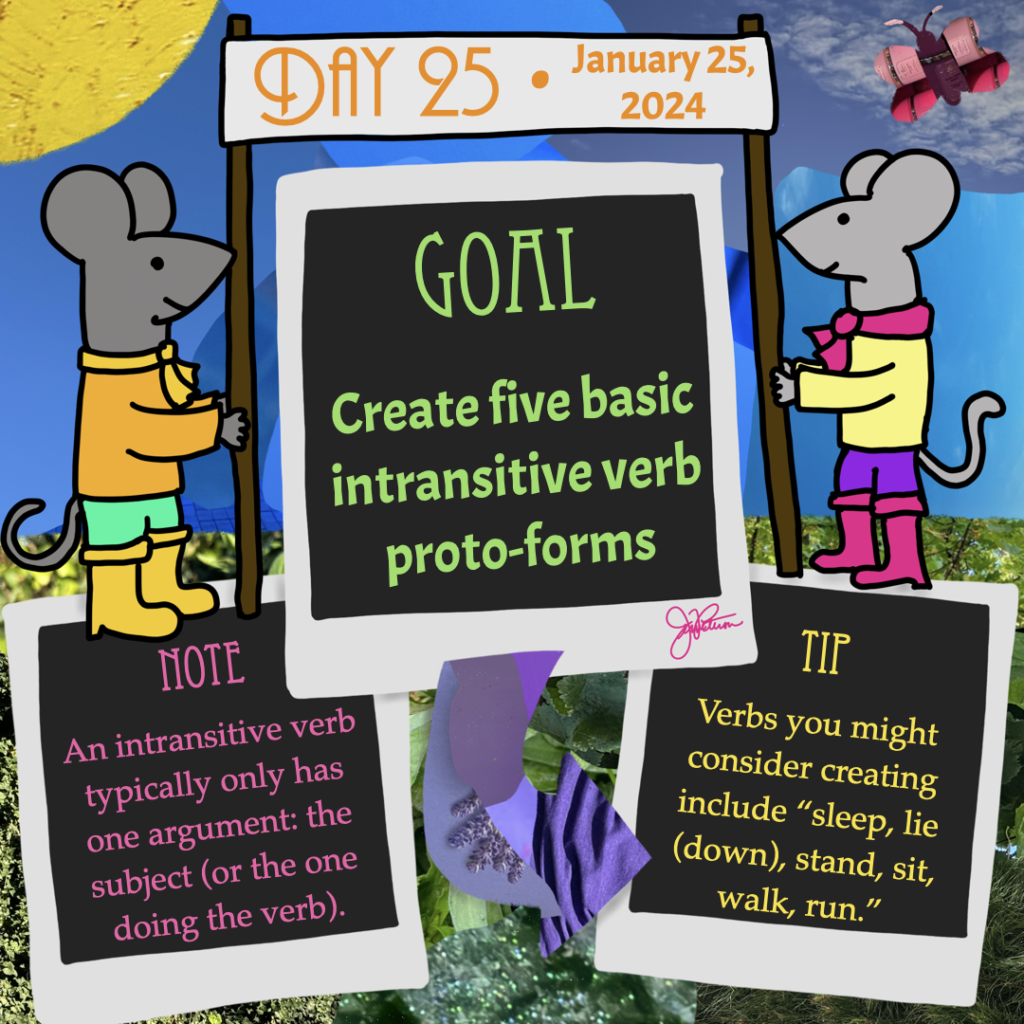
Goal: Create five basic intransitive verb proto-forms
Note: An intransitive verb typically only has one argument: the subject (or the one doing the verb).
Tip: Verbs you might consider creating include “sleep, lie (down), stand, sit, walk, run.”
Work focus: Create/Make/List
Yesterday you created some initial transitive verbs. Today shifts the focus to creating intransitive verbs, which are verbs that typically only occur with a subject, or the one doing the verb. As with yesterday’s prompt, you want to make sure these verbs are appropriate for your speakers and their world.
Common basic intransitive across languages include verbs of motion, such as “to walk, to run, to swim, to float, to fly.” These verbs may indicate how your speakers move about in their world, but they may also refer to the ways fauna (or even flora!) move. For instance, your speakers don’t need to be able to swim for it to be appropriate for you to create that verb as a basic root. Perhaps they live near a river and commonly see fish or fishlike creatures moving about in the water, making “to swim” an appropriate verb choice.
Other common intransitive verbs indicate a bodily position or a changing of bodily position, such as “to stand (up), to sit (down), to lie (down).” You may have noticed I included directional words in parentheses. Without the directional words, the meaning I intended to portray is one of stationary position: a person is standing (they are simply there, in a standing position). With the additional word, it indicates a motion to change from one position into another: a person is standing up (they were sitting down, but now they are standing).
It is possible that your language treats these concepts differently, where, for instance, your language may have basic verb roots of bodily position, such as “to stand, to sit, to lie,” but if speakers want to indicate a change in position to mean “to stand up” or “to lie down,” then they may need to use a special derivational marker to provide that meaning. On the other hand, your language can treat the concepts as part of the same verb, where context will make it clear whether a speaker means “to sit” or “to sit down,” for instance. (You may note that English speakers have the option to use those little directional adverbs to clarify their intended meaning, but, in many instances, verbs like “stand, sit, lie” are ambiguous as to whether the subject is stationary or changing positions.)
Bodily functions provide ways to develop common intransitive verbs, such as “to sleep, to sneeze, to breathe.” Of course, what your speakers do may be wildly different from human bodies, so you might create a basic verb like “to recharge” for robot speakers rather than creating a root meaning “to sleep.” Emotional reactions are a subtype of bodily function and are also common sources for basic intransitive verbs, such as “to laugh, to cry, to smile.”
You may also want to create verbs of communication, which may be intransitive, such as “to talk, to sing, to whisper, to whistle.” Again, you can think about what other inhabitants of your world do as you think of options for these verbs. If your speakers are surrounded by a variety of birds, they may have verbs to indicate the different ways of communication the birds have, such as “to hoot, to chirp, to sing, to call.”
Whatever you choose to focus on for today’s verbs, I hope you have some fun thinking through the many options!
